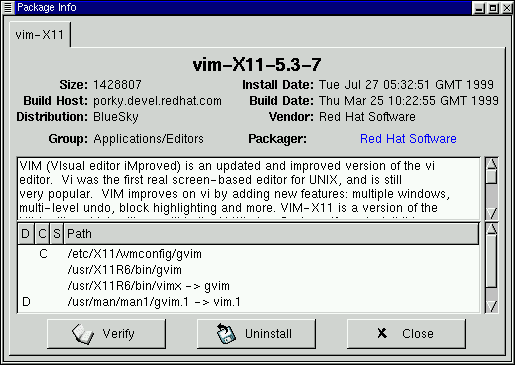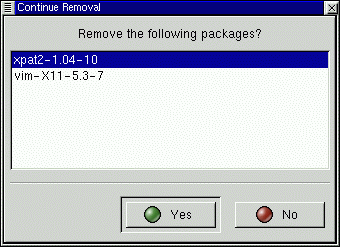Package Manipulation
Querying Packages
The easiest way to query packages is to use the Query option from the menu at the top. If you want to query more than one package, make all your selections then press the Query button on the menu.
You'll be presented with a window like the one shown in Figure 12-7. The more packages you've queried, the more "tabs" you'll find within the Package Info box, each tab representing a query response for the related package.
The name of the package is centered at the top of the box. Below, the box is divided into two columns of listed information; below this information, you'll see a display area showing package files.
In the left column of the information list, you'll find the size of the file, the machine on which the file is found, the name of the package distribution and the group to which its function belongs.
In the right column, you'll find the date of the package's installation on your machine, the date the package was built, the name of the vendor and the name of the group who packaged the software. If the package has not been installed on your machine, that space will simply read, "not installed."
Below the description is a list of the files contained in the package. If a D appears in its related column to the left of the path, that file is a documentation file and would be a good thing to read for help on using the application. If a C appears in its respective column, the file is a configuration file. Under the S column, you can view the "state" of the package; here, you'll receive information if any files are reported as "missing" from the package (which probably means there's a problem with the package).
If you're querying a package that's already installed, you'll also find two additional buttons beneath at the bottom of this window: Verify and Uninstall. If you're performing a query on a package that hasn't been installed yet, the buttons on the bottom will be labeled Install, Upgrade and Check Sig.
To close the query window without performing any action, left-click on the X at the top right of the window bar.
Verifying Packages
Verifying a package checks all of the files in the package to ensure they match the ones present on your system. This check can be used when you suspect that one of the program's files has become corrupted for some reason.
Uninstalling Packages
Uninstalling a package removes the application and associated files from your machine. When a package is uninstalled, any files it uses that are not needed by other packages on your system are also removed. Changed configuration files are copied to <filename>.rpmsave so you can reuse them later.
 | Make sure you're root |
|---|---|
Remember that you must be root to uninstall packages. |
If uninstalling a package would break "dependencies," a dialog will appear, asking you to confirm the deletion. This will occur if you haven't selected the "No dependency checks" box from the Preferences menu (as shown in Figure 12-8).
There are a variety of methods through which you can remove a selected package: from the menu, under Packages; from the toolbar and from the Query function.
Upgrading Packages
When a new version of a package has been released, it's easy to install it on your system; simply upgrade what you already have to the version that you want to install. The procedure is similar to installation of packages with the exception that you should select Upgrade rather than Install.
During the upgrade, you'll see a progress indicator similar to that for package installations. When the upgrade is finished, any old versions of the packages will be removed, unless you specify otherwise (refer to the section called Basic Configuration for more information).
It is much better to use the upgrade option than to uninstall the old versions of a package and then install the new one. (In fact, the RPM upgrade process will handle uninstallation and replacement of files. Refer to the section called Uninstalling to learn more about this process.)


